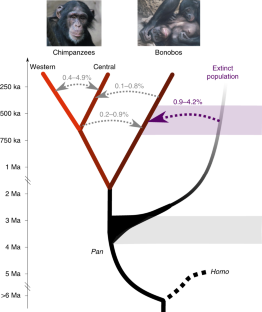
"Similar disruptions cause disease, which is why everything we learn from this helps us better understand human biology and chromosomal structures." "This explains why the gibbons have undergone so much change," said Rogers. In the gibbons, the team identified the LAVA element - a novel repeat element that emerged exclusively in gibbons and preferentially hits genes involved in chromosome segregation (an essential step in cell division, where chromosomes pair off with their similar homologous chromosome.) Repeat elements have the capability to disrupt a gene and change their biological function, Worley said. The sequencing project revealed a novel and unique genetic repeat element (segments of DNA that occur in multiple copies throughout the genome) that is inserted into genes associated with the maintenance of chromatin structure. "Up until recently, it has been impossible to determine how one human chromosome could be aligned to any gibbon chromosome because there are so many rearrangements." "It is like the genome just exploded and then was put back together," he said. The number of chromosomal rearrangements in the gibbons is remarkable, Rogers said. "There are also a number of other genetic diseases that result from these events." The gibbon sequence gives us more insight into this process," said Worley. "Cancer is clearly the biggest medical example of the impact of chromosome rearrangements. Wesley Warren and Richard Wilson of Washington University. Kim Worley, professor in the Human Genome Sequencing Center, and Rogers, both of Baylor and Drs. The genome sequence helps to explain the genetic mechanism unique to gibbons that results in these large scale rearrangements.

The new genome sequence provides important insight into their unique and rapid chromosomal rearrangements."įor years, experts have known that gibbon chromosomes evolve quickly and have many breaks and rearrangements, but up until now there has been no explanation why, Rogers said.

"The gibbon sequence represents a branch of the primate evolutionary tree that spans the gap between the Old World Monkeys and great apes and has not yet been studied in this way. Jeffrey Rogers, associate professor in the Human Genome Sequencing Center at Baylor and a lead author on the report. "Everything we learn about the genome sequence of this particular primate and others analyzed in the recent past helps us to understand human biology in a more detailed and complete way," said Dr. The sequence and analysis of the gibbon genome (all the chromosomes) was published today in the journal Nature and led by scientists at Oregon Health & Science University, the Baylor College of Medicine Human Genome Sequencing Center and the Washington University School of Medicine's Genome Institute. Chromosome structure and function is also intimately related to human genetic diseases, especially cancer. Chromosomes, essentially the packaging that encases the genetic information stored in the DNA sequence, are fundamental to cellular function and the transmission of genetic information from one generation to the next.


 0 kommentar(er)
0 kommentar(er)
